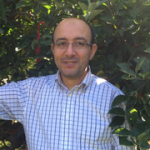By Achour Amiri, Assistant Professor of Plant Pathology, WSU-Wenatchee. July 2017
For most post-harvest diseases of apple and pear, infections are initiated in the orchard at different times during the growing season. As the harvest season is approaching for some early cultivars, it is time to think and plan pre-harvest fungicide sprays to enhance disease management post-harvest.
Major diseases to worry about: Several pathogens can infect fruit pre-harvest. However, there are a few that can result in major losses post-harvest. Gray mold, Bull’s eye rot, Phacidiopycnis rot, and Nectria rot, are those to watch closely and plan sprays for adequately.
What to do: Before thinking of fungicides, use sanitation to lower the risks of these pathogens. The pathogens which cause Bull’s eye, Phacidiopycnis, and Nectria rots all survive on cankers and necrosis and produce inoculum to infect fruit during the growing season. Cut out cankered branches regularly. For Phacidiopycnis rot, crab apple pollinizers can be an important source of inoculum known to increase rot incidence in storage rooms. Cut and remove mummified fruits from crab apple trees to lower disease pressure.
Timing and fungicide resistance risks are factors to consider when spraying fungicides: Sprays conducted during the last two weeks before harvest are important but may not always be sufficient to effectively control infections that started earlier during the season. Don’t forget about sprays earlier in the summer. However, additional research is being conducted to better understand the epidemiology of major pre-harvest infections in order to spray timely and accordingly.
Topsin-M (FRAC group 1), Pristine (FRAC groups 7+11), and to some extent Ziram (FRAC group M3) have been the most frequently used fungicides in the last decades in Washington orchards and the Pacific Northwest (PNW). Merivon (FRAC group 7+11) is a new fungicide registered in the last two years (Table 1). Topsin-M, Pristine, and Merivon are single-site fungicides, meaning they only target one site on the fungus. Any genetic change in this site will render it unavailable for the fungicide to attack and kill the pathogen. Ziram and (Captan) target different sites on the fungus, which makes them less prone for fungicide resistance development. However, they need to be applied preventively and higher rates are usually required.
When resistance is absent, Pristine and Merivon have a good efficacy against gray mold, a moderate efficacy against Bull’s eye rot, whereas recent research showed that Pristine is not effective against Phacidiopycnis rot. Merivon and Pristine are also registered to control powdery mildew in spring and early summer. However, in order to ovoid frequent sprays of these three pre-harvest fungicides, it is recommended to use other fungicides from the same and different chemical groups to control powdery mildew.
Topsin-M have a good efficacy against gray mold and bull’s eye rot. However, gray mold resistance has been documented in the PNW. Because a sister molecule, thiabendazole (TBZ, Mertect) is widely used post-harvest, the use of Topsin-M pre-harvest is questionable and should be restricted to lots which history of bull’s eye rot or in orchards planted to cultivars known to be highly susceptible to this pathogen.
Besides annual rotation of the single-sites Pristine or Merivon with Topsin-M, there is some evidence that incorporating multi-site fungicides can have a positive impact on disease control and on lowering fungicide resistance risks. Early results from studies conducted on Fuji and d ’Anjou indicate that tank-mixing single-site fungicides with Ziram is reducing the incidence of gray mold and other rots mentioned above in a better way than the singles-sites applied alone.
Table 1. Fungicides registered for pre-harvest applications on apple and pear in the Pacific Northwesta
a Always consult label as some restrictions may apply.
b Efficacy based on efficacy trials and known occurrence of resistance. Efficacy may vary based on timing of application and disease pressure. ++, +++, ++++ indicate moderate, good, and very good efficacy, respectively.
c Resistance occurrence in the Pacific Northwest region. Resistance to Merivon (Penthiopyrad FRAC Group 7) is expected because of some cross-resistance with Pristine (Boscalid FRAC group 7). -/+, ++, +++ indicate sporadic, low, and moderate resistance frequency, respectively, through orchards of the Pacific Northwest.
d Postharvest interval period in days.
Disclaimer:
No endorsement is intended for products mentioned, nor is lack of endorsement meant for products not mentioned. The author and Washington State University assume no liability resulting from the use of pesticide applications detailed in this report.
Contact
Dr. Achour Amiri
Tree Fruit Research and Extension Center
509-663-8181 ext 268


